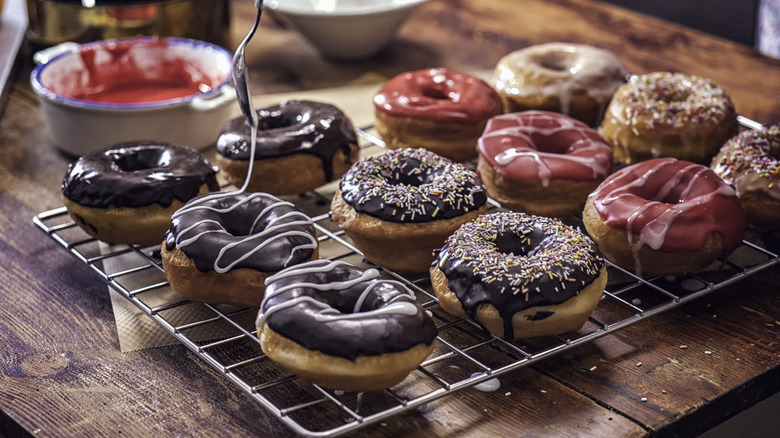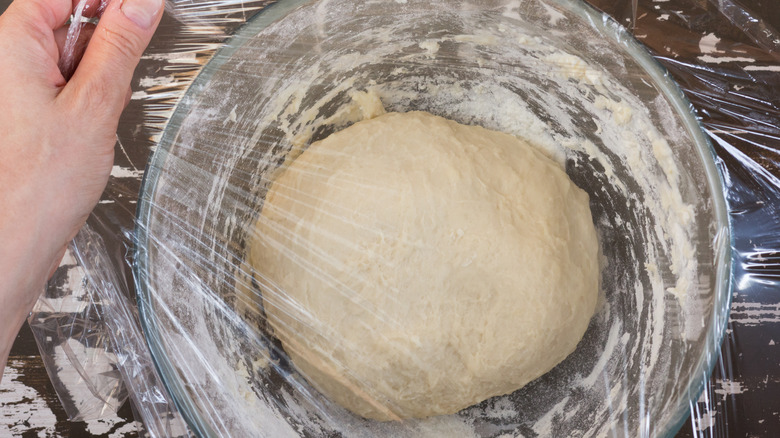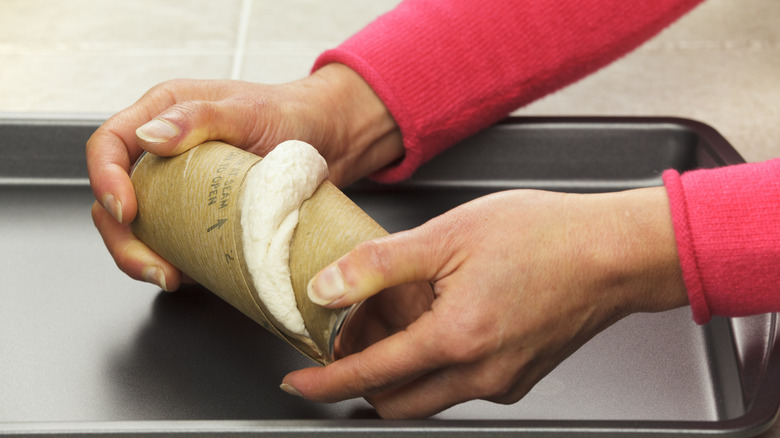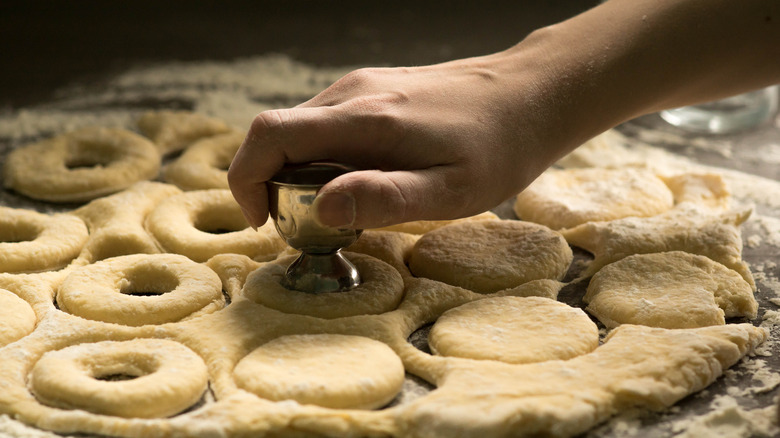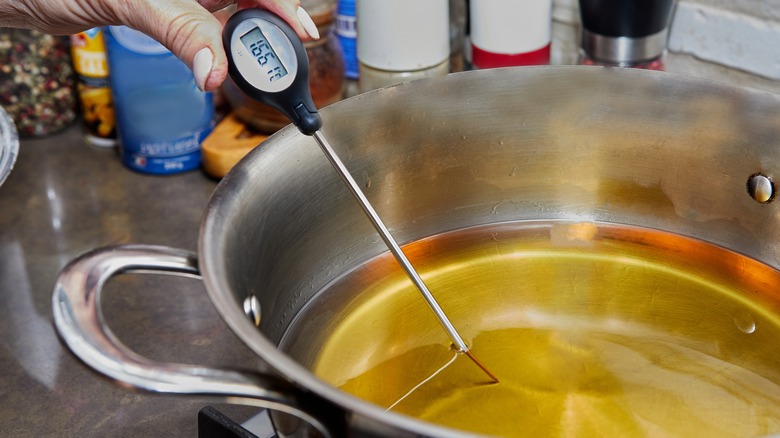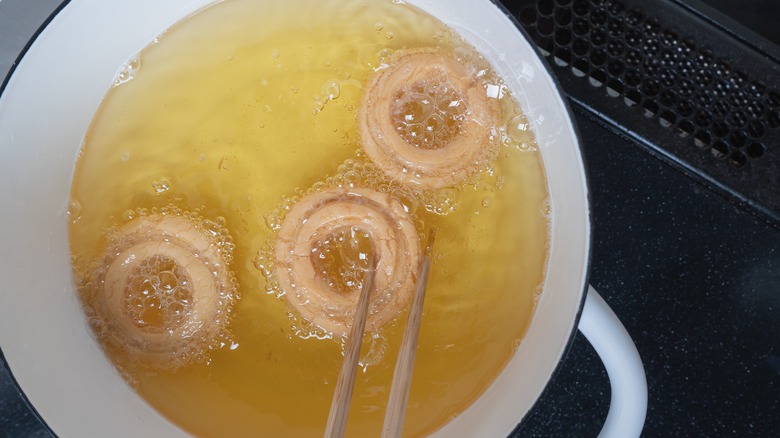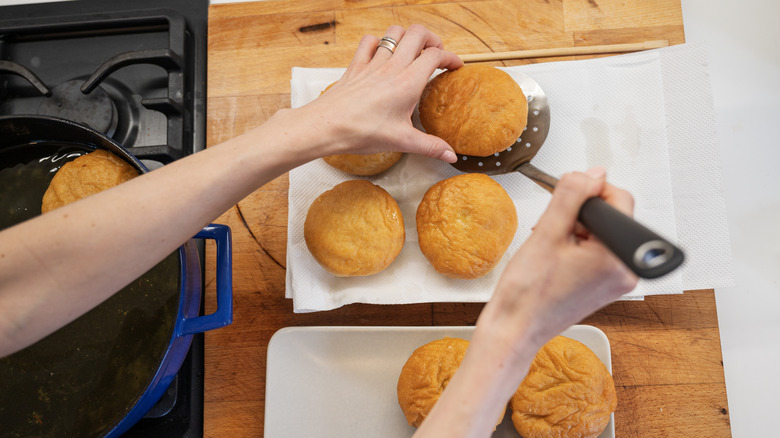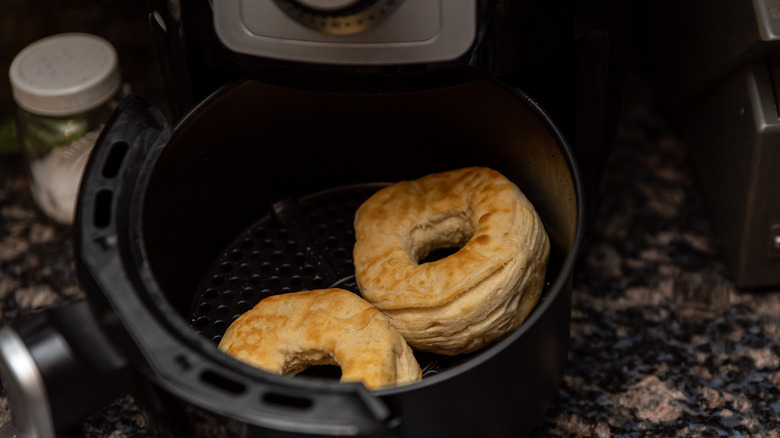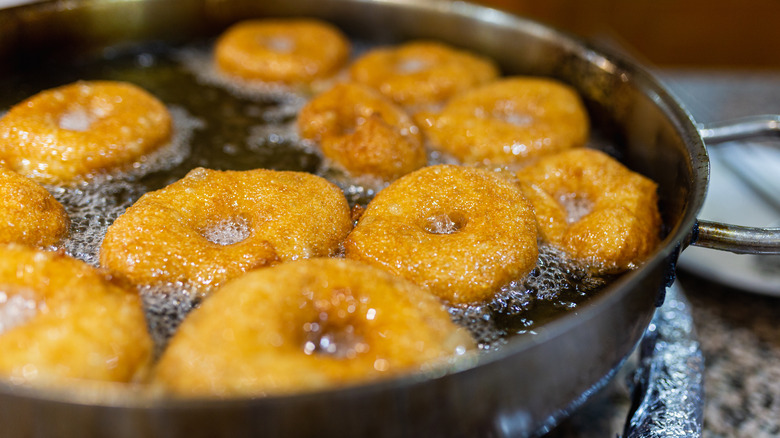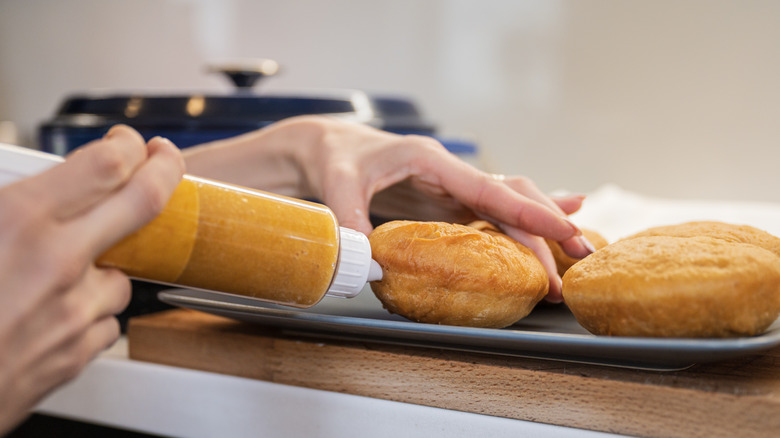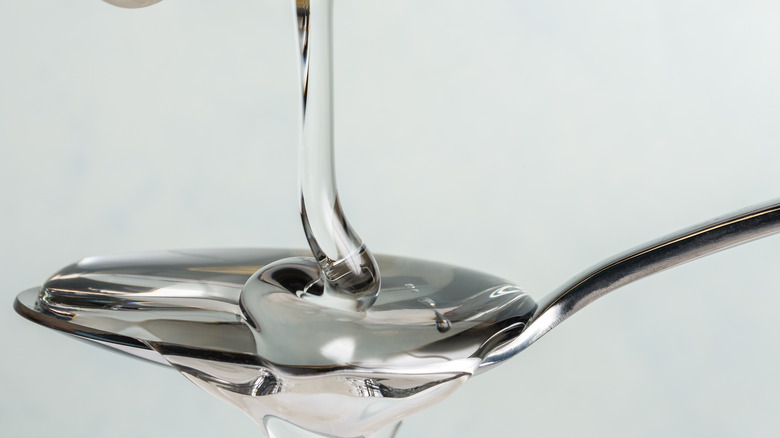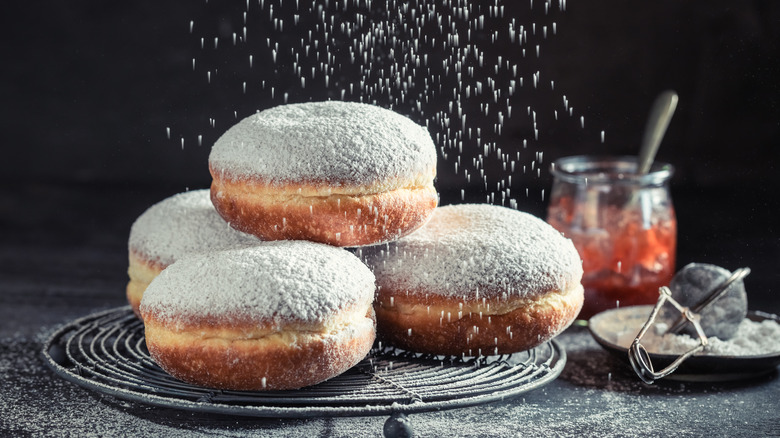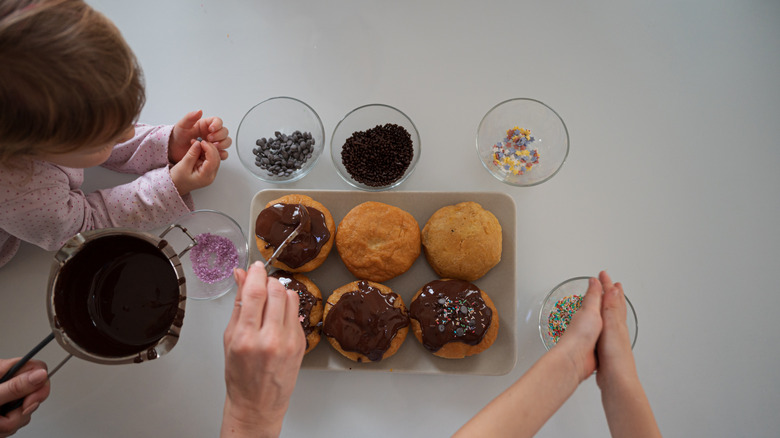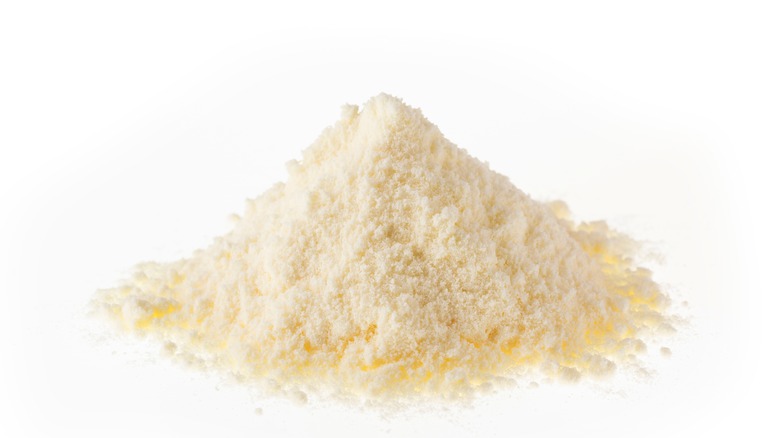13 Tips For Making The Absolute Best Donuts
Donuts might be one of the food items you typically leave up to the pros, but it doesn't have to be that way. In reality, once you know essential tips for making them from scratch, they aren't out of bounds for home cooks and bakers. And yes, you can even make homemade donuts just as delicious as the ones from a donut shop. Before you know it, you will effortlessly create a pillowy dough and shape and fry the pastries to perfection.
And don't forget that the techniques to decorate them are just as crucial. You don't want to mess up all your hard work to get to that point, but lucky for you, all the information you need is here. There are various ways to garnish the fluffy pastries, such as using powdered sugar, cinnamon sugar, or shiny glaze. Or maybe you prefer the classic ring donut with a top layer of icing and sprinkles. Nevertheless, here are some beneficial tips so you can make finger-licking and picture-perfect donuts with ease.
1. Use proper mixing and proofing methods
Typically, when you set out to make donuts, your recipe is either for cake or yeast donuts. The significant difference between the two types is what ingredient makes them rise and gives them their distinct texture. As you can probably guess, yeast donuts are made with baker's yeast. On the other hand, cake donuts get their lift from chemical leavening agents, such as baking powder and baking soda. It's crucial to follow the recipe when you make these sweet treats since each kind requires specific steps to ensure they turn out correctly.
For instance, if you use active dry yeast for donuts, you must first bloom it in warm water or milk to activate it. Also, yeast donuts take much longer because you need to proof the dough. Otherwise, they turn out unpleasantly dense. Some recipes even require two rounds of proofing, where you allow the dough to rise both before and after you shape the donuts. Many folks prefer cake donuts because they're quicker to make since the chemical leavening agents allow you to skip the proofing steps. Both doughs require you to knead them gently. Yet, you need to be careful not to overmix or knead them for too long because then you make the gluten tighten, resulting in a donut that's the opposite of fluffy.
2. Make it easy by using pre-made dough
If making the dough from scratch isn't exactly appealing to you have no fear because you can transform different types of pre-made dough into donuts with a bit of creativity. For instance, you probably have the key to easier-than-ever donuts in your freezer: pre-made puff pastry. With this type of dough, remove it from the freezer, roll it if needed, and cut the donut rings out. Then, fry them as usual, and you have quick, buttery donuts in no time! However, this isn't the only store-bought dough you can use.
Biscuit dough is the easiest since companies already form the biscuits into pre-cut circles that come in tubes, and you just need to cut the donut holes out (unless you want to keep them whole and put a filling). Cook the biscuit donuts in the air fryer or fry them in oil for about 2 minutes on each side. You can also use crescent roll dough, which essentially creates cronuts — a cross of croissants and donuts — but they take more work. You must remove the dough from the can, press the seams, and fold it to the correct thickness. Then, stamp the shapes out and fry them until all sides are golden.
3. Roll and cut them with care
The way you roll out your dough will affect how the donuts cook. For instance, if the dough is too thin, the donuts turn out flat and don't have the best presentation. Meanwhile, they have trouble cooking in the center if you roll it too thick. Therefore, it's essential to roll the dough to ½-inch thickness for optimal results.
Additionally, when you cut the shapes, use very sharp tools, otherwise, the dough tears, and it's difficult to separate it from the rest because it's more of an imprint than a cut. However, the worst part is that when the donuts cook and don't have pristine edges, they don't look as uniform as they should.
To make traditional donut rings, you need two cutters — a large one and a smaller one — to cut the hole out. If you don't have round cutters, you can use the cap for cooking spray, although you should press it harder since it's not sharp. Extra tin cans from canned veggies (cleaned and dried) have a nice edge, so they're always a good alternative. Then, you just need to look around your kitchen to see what to use for the smaller hole, like a piping tip base or a condiment bottle cap.
4. Prepare the frying oil
The oil directly affects how the pastries turn out, so it's vital to know the type of oil to use, what temperature it needs to be, and how to maintain it during frying. First, don't use old oil because the donuts might take on flavors from other foods you just fried. For the most delicious pastries, use brand new oil and one with a neutral flavor (like vegetable or canola oil) that doesn't give the donuts a funky taste. Whether you plan to use a deep pot or a fryer, there needs to be enough oil in it for the donuts to float and cook properly — about 4 inches worth of oil minimum.
Before you transfer the dough to the pot, wait for the oil to reach 350 degrees Fahrenheit, but no higher than 375 degrees Fahrenheit. It's ideal to use a cooking thermometer to monitor the temperature while the pastries cook because if the oil dips to a lower temperature, the donuts soak up all of the oil and they won't get as brown. Meanwhile, if the temperature is too high, the donuts cook quickly on the outside but remain raw internally. If you notice the temperature isn't right when you cook them, remove the pastries momentarily while adjusting the temperature.
5. Use the correct tools for frying
It is wise to have tools that make the entire process easy, especially when you work with oil. You need a tool to help you flip your donuts that won't splash hot oil everywhere or cause your hand to be too close to the oil in general. A good route is to use chopsticks because they're easy to maneuver and aren't bulky like other kitchen utensils that have trouble getting underneath the donut.
To flip the pastries with chopsticks, put some slight pressure on the side of the donut, and it effortlessly turns over so the other side can cook. You can use extra-large ones or just standard-sized chopsticks, but ensure their material is heat-safe first. When you remove the cooked donuts from the oil, use a wire strainer or slotted spoon so you don't spill hot oil everywhere. You need the holes so all the oil stays in the fryer or pot and doesn't come along with the donut.
6. Drain the cooked donuts
For the best possible donuts, you need to get rid of excess oil on them, otherwise, they turn soggy and greasy. As mentioned, if you use a wire strainer, it helps to eliminate a lot of fat, especially if you hover it above the hot oil and gently shake the donuts. When you do so, you can visibly see oil drip back into the pan or fryer, which is a good indication. Once the drips stop, it's still not enough, though.
You need to take it a step further with paper towels, which are often more absorbent than linens. Ideally, before you begin, set up the paper towels so you can arrange the cooked pastries on them as soon as you need to. After a minute, the paper towels turn greasy, so you need to transfer them once more. Use a cooling rack so that they have airflow, which helps the donuts dry and have a crispy exterior.
7. Try the air fryer for easy cleanup
Although people cook classic donuts with oil, the air fryer does a wonderful job of making them crispy too. It's pretty convenient when you don't want to cook with a ton of oil or enjoy an easier cleanup. There are a couple of downsides to it, but they aren't too substantial, with the first being that domestic air fryers are often small and might not be able to cook as many donuts at once. In turn, you have to separate the dough into more batches. Secondly, although the pastries become crisp on the outside, they don't get as dark in color with the air fryer.
When you fry them, the Maillard reaction (the chemical reaction that makes food have a deeper flavor and darker color) is much stronger, which results in an extra enticing donut. However, it's not the end of the world if they're not dark, especially if you plan to top the donuts with icing or decorations. When you use this appliance, you have to flip over the donuts halfway through the cooking process as you do with the standard oil cooking method. And the good news is that you can also use the pre-made dough options, like the crescent or puff pastry donuts, in the air fryer too.
8. Don't overcrowd the pan
Whether you use a frying pan or you cook the doughnuts in an air fryer, don't make the mistake of placing too many in the pan at once. When the doughnuts don't have space around them, they can't grow in size while they cook; they might also get stuck to each other. This makes it harder to flip them and even harder to remove them once you finish cooking them.
Especially if you take the traditional route with oil and have too many to handle, you don't want to be overwhelmed with how many you need to pull out before they overcook. Aside from that, though, the main cause for concern is the oil temperature. When you overload the oil with the raw dough, it decreases the temperature, and as you now know, it needs to be within a specific range for your pastries to turn out right.
9. Have a game plan for filling the donuts
Try not to go in mindlessly and decide last minute that you want to fill donuts. First, if you cut holes out of every donut, it is impossible, or at least very difficult, to put filling inside. So, leave some large circles whole to save yourself the trouble. Also, make sure to have any tools for filling them set up beforehand so you don't have to rush around the kitchen looking for them. There are many easy ways to inject them with jam, custard, or other mixtures.
For example, you can make it simple by purchasing a donut injector, which is precisely what it sounds like. Put the filling in the injector and press or squeeze it into the donut after piercing it. However, not everybody has fancy equipment like that, so you can always use a knife or a chopstick to drill a small hole in the donut, then use a piping bag to inject the mixture inside. Whichever way you go, be careful when you do so because if you put too much filling in, it slowly leaks out or causes the donut to crack open. As soon as you feel resistance against your injecting tool, it likely means there's no more room inside.
10. Add corn syrup to the glaze
Most donut glaze recipes have a simple formula with minimal ingredients (powdered sugar, water or milk, and maybe a splash of vanilla extract). However, that type of glaze is not always as shiny as you want it to be. Plus, it doesn't necessarily set into a shell coating that well-known pastries like Krispy Kreme donuts have.
Corn syrup is the way to go when you want to achieve a look and texture for your glaze that is comparable to donut shops. It makes the coating glossy and prevents it from cracking, which often happens because it loses moisture over time. For best results, use light corn syrup since it's colorless. If all you have is dark corn syrup, it still works, but the glaze doesn't turn out as translucent (at least the deep molasses flavor is pleasant, though). You don't need much corn syrup for it to make an impact; start with 1 tablespoon and adjust from there as necessary.
11. Use hacks to make the powdered sugar stick better
When you want a simple powdered sugar topping, it can be tricky to apply it correctly and have it stay on the donut long term. Sometimes the sugar dissolves, and it's not always a good idea to add more since it makes the pastries taste sickly sweet. Luckily, with the help of neat tricks, you don't need to worry about this issue anymore. Firstly, add some cornstarch to the mix, which is the hack that prevents the powdered sugar from melting and turning into a sticky mess.
The cornstarch is beneficial because it looks very similar to powdered sugar, so it's not as if it changes the garnish's look, and it doesn't change the flavor either. Use 4 teaspoons of cornstarch for every 1 cup of powdered sugar, and you won't have any issues. Additionally, if cooking spray is available, lightly spray the top or the entire doughnut to give it a light base coat before you dip or sprinkle the pastries with powdered sugar. It's the easy oil trick that helps powdered sugar stick to donuts long term.
12. Add the toppings at the right time
Temperature plays a significant role in the presentation whether you top, thoroughly dip, or fill the donuts. If you plan to use a clear glaze that coats the entire donut, wait until you can comfortably handle them; ideally, the donuts shouldn't be hot or cold but in between, which helps the glaze go on more evenly. However, if you plan to fill them and put thicker icing on top, wait until they are at room temperature. Otherwise, the custard, jam, or pudding melts and becomes too liquid-like.
Also, don't make the mistake of decorating the outside before you fill them because it is challenging to place the filling without messing up the glaze. Meanwhile, you can toss hot donuts in granulated sugar since it sticks better while the donuts are warm, similar to when you coat churros. For powdered sugar donuts, wait some time for them to cool since they are more fragile than granulated sugar donuts.
13. Use Gordon Ramsay's malt powder method
Gordon Ramsay has a unique trick for making donuts extra delicious, and it's certainly worth trying out if you want your morning pastries to stand out. Ramsay mixes a small amount of dried malt powder into his cane sugar topping, which gives it a unique and nutty flavor. The amount to use is easy to remember, too, since it's a one-to-one ratio. Although he likes to coat his donuts in sugar, he fills them with chocolate.
Malt powder enhances chocolate's best qualities, so people commonly put it in things like chocolate milkshakes or ice cream. Therefore, Ramsay's technique is clever because it gives the donuts a decadent and nostalgic feel. If you don't want a sugar topping, you can always take advantage of the malt powder in other ways. For instance, use it in a chocolate glaze to amplify the chocolaty flavor, or add it to the donut dough before you cook them.
